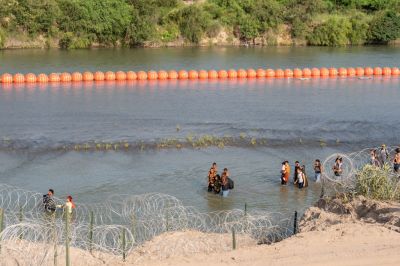A federal judge could decide soon whether to allow Texas Gov. Greg Abbott to continue using a 1,000-foot buoy barrier in the Rio Grande to keep illegal immigrants out of Texas. What may go unanswered for now is how far states can go in crafting their own immigration policies.
The Department of Justice (DOJ) asked Senior U.S. District Judge David A. Ezra in a July 26 filing to order Abbott to remove the barrier. The government argues the barrier runs afoul of federal environmental laws, presents humanitarian concerns, and prompted Mexico’s government to lodge protests “at the highest diplomatic levels.” After a dead body was found caught in the buoys earlier this month, Mexico’s Foreign Ministry slammed the buoys as a “violation of our sovereignty” in a statement.
Abbott shot down the administration’s request to remove the barrier and seemed eager for a courtroom confrontation, taking to social media after the lawsuit to retort: “Mr. President, Texas will see you in court.” He has argued that the Constitution gives Texas the “sovereign authority to protect its borders because the President refuses to enforce federal immigration laws.”
What is the DOJ’s argument for stepping in?
The case, the DOJ argues, concerns a “straightforward violation” of the Rivers and Harbors Act of 1899, which primarily prevents any navigable waters from being impeded by “wharf, pier, dolphin, boom, weir, breakwater, bulkhead, jetty, or other structures in any port, roadstead, haven, harbor, canal, navigable river, or other water of the United States” without the consent of the Army Corps of Engineers.
The Rivers and Harbors Act “goes all the way back to when people were putting up chains and barricades across rivers, and charging fees to go up the river,” Jim Blackburn, an environmental law professor at Rice University, told The Austin American-Statesman. The adverse impact on commerce caused the federal government to give the Army Corps of Engineers authority over navigation.
According to the DOJ’s complaint, Abbott failed to get a permit from federal authorities before deploying the buoys in July. The barrier interferes with federal authorities’ ability to carry out operations on the Rio Grande, the DOJ says.
The government also argued that Texas is running afoul of bilateral agreements between the United States and Mexico regarding the Rio Grande. The winding river, the demarcation between the United States and Mexico, falls under the jurisdiction of the International Boundary and Water Commission, which oversees U.S.-Mexico treaties and is charged with “the settlement of all disputes” over the Rio Grande that might arise in the wake of the Water Treaty of February 3, 1944.
The commission said Texas did not notify it about the barrier ahead of its installation.
The buoys, which are about 6 feet in diameter, cover 995 feet in the middle of the Rio Grande. They are connected via chains to concrete blocks anchored in the riverbed. Netting prevents anyone from swimming under them. The International Boundary and Water Commission last month determined that 787 feet, or around 79 percent, of the barrier was floating on Mexico’s side, according to its filing in the case, though Texas has since moved them.
What is Texas’ argument?
Abbott argues the buoys don’t run afoul of the Rivers and Harbors Act because they can’t be compared to the specific structures the act forbids: They’ve been deployed in shallower parts of the river that can’t be considered navigable—“in a segment of the Rio Grande comprised of sand bars, shallow water, water with inconsistent depths, small islands, large rocks, man-made debris, natural debris such as logs and stumps, and sandy shoals,” as a Texas filing says.
But Abbott is also making a much broader argument, essentially arguing that migrants flooding into Texas from Mexico constitute an invasion that requires military force. His sprawling, $4 billion, two-year-long border security initiative, dubbed Operation Lone Star, has raised thorny questions about the measures states can take over and above federal immigration law. In Operation Lone Star, Abbott has deployed thousands of feet of concertina razor wire, bused migrants to various cities, and set up a separate justice system to adjudicate misdemeanor state trespassing charges against migrants.
In November, Abbott “invoked the Invasion Clauses of the U.S. & Texas Constitutions to fully authorize Texas to take unprecedented measures to defend our state against an invasion,” he said. The state’s constitution does grant the governor “power to call forth the militia to execute the laws of the State, to suppress insurrections, and to repel invasions.”
The U.S. Constitution mentions invasions twice. Article I says states shall not keep troops or engage in a war “unless actually invaded, or in such imminent Danger as will not admit of delay,” while Article IV stipulates that the federal government is responsible for protecting every state in the union “against invasion.”
An amicus brief filed by the conservative Immigration Reform Law Institute, contends that Abbott was essentially exercising war powers: “The Constitution explicitly recognizes that Texas retains its inherent authority to exercise war powers in the event of an invasion, and in doing so is not subject to the control of Congress,” attorney Matt Crapo wrote.
How sweeping could a ruling be?
Lawyers have until Friday to submit closing arguments, and Ezra is expected to hand down his ruling soon after. Although most legal experts think it unlikely, Ezra, a Reagan appointee, would issue a broader legal ruling when a narrower pathway is clearer.
DOJ lawyers have for the most part steered clear of addressing Abbott’s immigration policies writ large, only briefly responding to Texas’ arguments about sovereignty and border control. Instead, they have stuck to their original contention that the issue here is how the court interprets the word “navigable.”
“Whether and when an ‘invasion’ occurs is a matter of foreign policy and national defense, which the Constitution specifically commits to the federal government,” the DOJ argued in a court filing last week. An invasion is “armed hostility from another political entity,” which doesn’t apply in these circumstances, it contends. “Immigration is not the kind of “invasion” contemplated by the Self-Defense Clause,” the filing adds.
The “plain language [of the Constitution] has never been read this way,” Laurence Benenson, vice president of policy and advocacy with the National Immigration Forum, tells The Dispatch.
Ezra also seemed skeptical of Texas’ arguments during a Tuesday hearing, particularly its claim that buoys were necessary for controlling the border. He instead signaled the case is likely to focus on the navigation aspects—not the wider immigration policy implications.
“This is a U.S. District Court. It is not Congress,” Ezra said, according to the Texas Tribune. “I’m not here to engage in nor do I have any inclination to engage in any type of political comment in this decision.”
And if Ezra does keep his ruling to the navigation issue, the effects will be limited in scope.
“This is not a massive multimile border wall,” Aaron Reichlin-Melnick, a former immigration lawyer with the American Immigration Council, tells The Dispatch. “At the end of the day, it’s 1,000 feet on a 2,000 mile border. This is not changing anything about how people are crossing the border other than at this very, very specific place.”






Please note that we at The Dispatch hold ourselves, our work, and our commenters to a higher standard than other places on the internet. We welcome comments that foster genuine debate or discussion—including comments critical of us or our work—but responses that include ad hominem attacks on fellow Dispatch members or are intended to stoke fear and anger may be moderated.
With your membership, you only have the ability to comment on The Morning Dispatch articles. Consider upgrading to join the conversation everywhere.